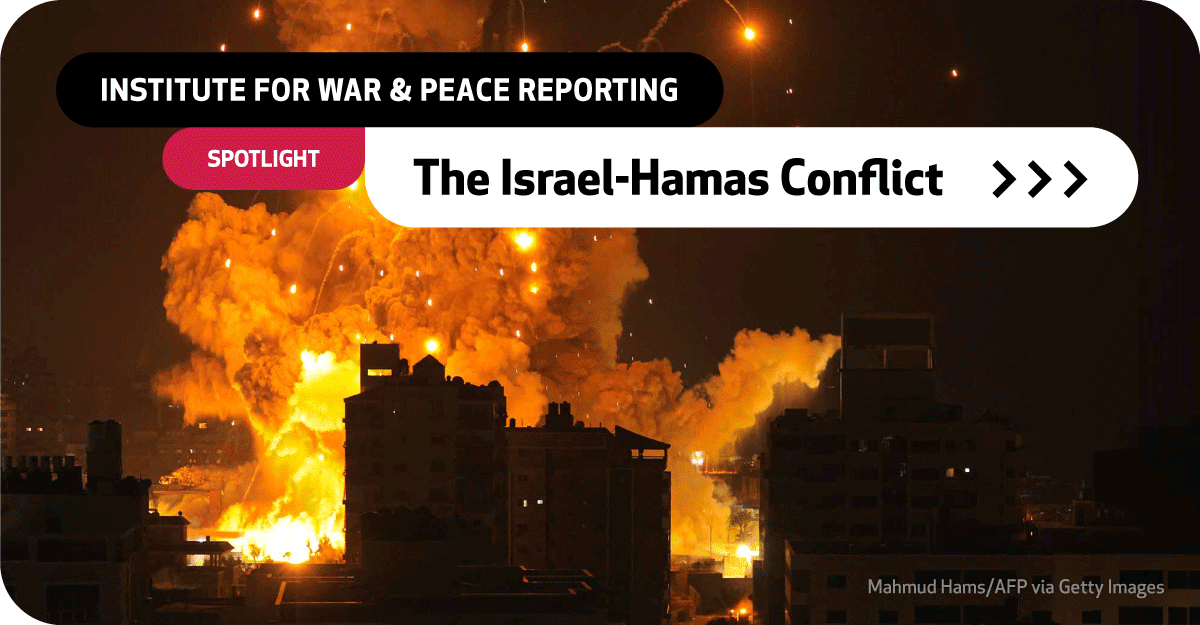Interview: The War on Disinformation
Open source intelligence (OSINT) can provide facts – but impatient, angry audiences often prefer opinions.
The Israel-Gaza conflict has seen a vast flow of disinformation spread via social and traditional media. Eliot Higgins, founder and creative director of pioneering OSINT collective Bellingcat, tells IWPR managing editor Daniella Peled how the “grotesque” online discourse was amplifying trauma and perpetuating a cycle of violence.
What are the particular challenges Bellingcat is facing working on the Israel-Gaza war?
After decades of conflict people already have their established opinions, and it's made it very difficult to have any kind of online discourse that isn't fueled by entrenched positions on either side. That, combined with Elon Musk’s alterations to Twitter, has created an environment that's ripe for disinformation and the spread of misinformation.
“The disinformation is the worst I've ever seen, by a significant factor.”
It's honestly the worst I've ever seen in any situation I've experienced, by a significant factor. Not only do people have very strident views on what's happening, they also want answers really, really quickly. This puts more pressure on those doing OSINT when in fact some incidents can take a very long time to investigate, even if it’s possible; sometimes it's just impossible to be completely sure.
But people want clear, definitive answers, and when they don't get them they seek out those who will provide them - generally based on political opinions rather than evidence.
The explosion at the al-Ahli hospital in Gaza has been one of the most highly contested events of the war. What has your work involved and what are the implications of the findings?
We're currently reviewing all the OSINT evidence – videos, photographs, geo-locating - to do basic analysis to exclude certain scenarios.
For example, examining the crater at the impact site showed that was not something caused by a large bomb. So the initial claims that this was an airstrike don’t match the available evidence. That's not to say Israel didn't do it; that's just to say that specific scenario can be excluded.
Usually when you have a crater of the type that we're seeing, quite small with shrapnel emanating from it, it's an indication of a surface-to-surface munition or maybe a quite small air launched munition - a rocket, missile or mortar. But what complicates things is usually you can get a direction of fire from these craters and can figure out where the fire is coming from. If it is a misfired rocket, we can't assume the trajectory is stable or draw assumptions about the launch site. We also not seeing any munition debris being recovered from the site, which makes it very difficult to assign responsibility.
There were statements from various sources in Gaza, first that a warhead had been recovered from the site, which in itself is quite unusual because those usually explode in these circumstances, or that the entire munition completely disintegrated, which is very unlikely.
We’re trying to use the footage filmed on the night and the following day to see any signs of that debris. But for the moment we've not found anything.
Also, this munition landed close to a group of people camped out on a grassy area. They had a large amount of personal belongings that were cleared away the following day. It could be some of this was picked up, people thinking it was part of the building that had been blown up, mixed in with other stuff. But we don't know because we didn't see that process or have any evidence about what was happening on the ground.
We've seen reporting in The New York Times about a video claiming to show a Palestinian rocket launch, which they've identified as being launched from Israel itself. But it seems to have nothing to do with the attack on the hospital.
It's a very complicated situation; I think ultimately it's going to be very difficult to give 100 per cent certain answers on exactly what happened with that attack.

What work have you been doing on the October 7 kibbutz attacks?
The most basic thing we can do is verify where and when these videos were filmed. It's key to examining the facts and trying to remove the politics and the emotion from the situation, even though that can be very hard to do in such distressing circumstances. There are always going to be voices who claim that this stuff is fake.
Sometimes Bellingcat’s work is building verified data and analysis that other organisations can then look at and build on with their own work. It’s improving the quality of information to give clarity to not just general audiences, but organisations using it for their own work.
I have to say the discourse I've been seeing online has been quite grotesque for a number of reasons. One was this picture presented by Israel of a burnt corpse of a child, and then a Twitter user ran it through a kind of AI detection website, and it came out as an AI generated picture. That was used to dismiss this and more broadly to dismiss all Israeli evidence, by people who didn't want to believe it. But we tested this website and it has a very high error rate, so it's not a valid technique to analyse this kind of imagery.
The way in which people use the blood of innocents like that to gain clicks, likes, followers and subscribers is really disgusting.
I've seen a lot of misattributed images from other conflicts, for example people using images from Syria to say, ‘this is what Israel is doing to Gaza’. I also find that disgusting, especially when it's often done by people who denied Assad’s war crimes in Syria, and are now using those same war crimes to blame Israel for war crimes in Gaza? I find it absolutely appalling and offensive.
What kind of role might OSINT play in any future justice processes around this conflict?
We've developed a process over the last four years specifically intended to use OSINT in legal processes. It’s very intensive in terms of resources, so we're focusing on Ukraine at the moment. There's a project which I'm running for the last 18 months where we're creating case files using open source evidence and analysis.
“The way in which people use the blood of innocents to gain ‘likes’ is really disgusting.”
It would be possible to do that with this conflict, but where would that be used? With Ukraine, you've got international courts that can use this evidence. That is not so clear with the conflict between Israel and Hamas. But part of the reason we're developing this process is to train organisations how to do this so that it can be used to move towards accountability. There's been a lot of progress in the last two years in how you use OSINT evidence for legal accountability. While it's not intended to replace traditional investigation, it can do a lot to complement those processes.
What is the psychological impact on those scrutinising this sort of content?
At Bellingcat we've got a really good awareness of this because we've been doing this work for a very long time. We understand the impact of vicarious trauma from seeing traumatic imagery.
As professional human rights researchers and journalists, there's an understanding of that and the impact that has on you. But social media users who don't really think about those risks are being traumatised.
I saw recent Tik Tok spats where someone posted a video on the situation and said at the end that people should take time off, log off, stop watching that kind of content, which is good advice.
But the response to that was quite angry. “How dare you tell us not to be a witness to what is happening?” That is a reflection of a trauma response from people who feel powerless and see witnessing as a way of taking power, saying, ‘I didn’t turn away’. But the way they're handling that trauma can be very, very damaging in the long term. It creates people who have increasingly extreme points of view. It draws them into communities that just reinforce anger and that hatred.
Unfortunately, social media is very good at amplifying that effect. It's really some of the worst that I've seen around any conflict. Everyone is expected to have an opinion on Israel and Palestine and take one side or the other in this very unproductive way, and that allows the cycle of violence to repeat, rather than trying to address the issues and deal with the real human cost.

